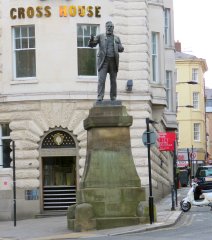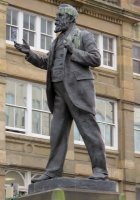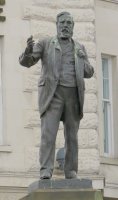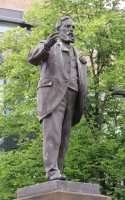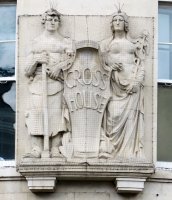The statue of Joseph Cowen in Newcastle is a good example of the work of sculptor John Tweed, who made a good number of public statues around England, mostly of military subjects.
The statue of Joseph Cowen stands facing down Westgate Road at the corner of Falconar's Court, which immediately becomes Fenkle Street. We see an Victorian figure with beard and bulky clothing, one hand on his jacket, the other gesturing to make some point, for Joseph Cowen MP was an independently-minded politician and orator, and supporter of the Jewish community. The slightly baggy look is apparently characteristic of his appearance, but is not so remarkable. However, it is not from the front, but from the profile view that the statue impresses, by virtue of the feel of movement, one leg thrust forward, that arm extended.
Different aspects of the statue.
The sculptor, John Tweed, did rather favour poses with one foot forwards, and he often depicts a degree of movement, but the Joseph Cowen statue has a dynamism not found in most of his other statues. Tweed, Scottish born, settled in London, and among various statues there, his Clive of India just off Whitehall facing St James Park is probably his most distinctive statue.
Cross House, the distinctive block behind the Joseph Cowen statue, has a nice stone sculpture on the short frontage to the corner: a panel with a shield bearing the name, 'Cross House', with a pair of figures flanking it. To the left, a labourer, bare-chested and wearing a thick apron, with heavy hammer and pliers; he is, I would think, emblematic of Industry or Manufacture (more pictures symbolising Industry on this page). To the right, a semi-nude classical girl, carrying a winged staff with two snakes wound around it - this is the Cadaceus (see this page for lots of examples, the staff of the Greek God Hermes, herald and messenger of the Gods, also emblematic of Trade. So the pair together are highly appropriate for a building in the manufacturing and trading centre of Newcastle.
Cross House architectural panel with figure sculpture.
The building itself replaced a 17th Century mansion, a little set back so it had a 6-bay frontage rather than the two bay frontage of the building today, with a small walled courtyard in front. The current building, designed by Cackett and Burns Dick and erected in 1911-12, thus after the statue (which was put up in 1906), is faced with Portland Stone, rather different from most Newcastle buildings. It is known for having suffered a fire just after WW1 which killed 11 people in the building.
Also noted on these pages in Newcastle: Grey's Monument
